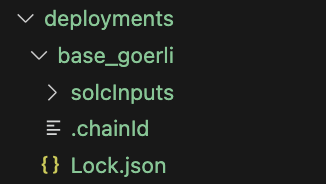Deploying Smart Contracts
In this article, you'll learn how to deploy smart contracts to multiple Blockchain networks using Hardhat and Hardhat deploy.
Objectives
By the end of this lesson, you should be able to:
- Deploy a smart contract to the Base Sepolia Testnet with hardhat-deploy
- Deploy a smart contract to the Sepolia Testnet with hardhat-deploy
- Use BaseScan to view a deployed smart contract
Overview
Hardhat capabilities enable developers to deploy smart contracts easily to any Blockchain by simply creating tasks or scripts. However, due to the Hardhat architecture that enables its extension by creating plugins, you can rely on existing solutions developed by the community.
Hardhat deploy is a community-developed plugin that enables the deployment of your smart contracts in a simple way.
Setting up Hardhat deploy
To install:
- Run
npm install -D hardhat-deploy. Then, import hardhat-deploy inhardhat.config.ts:
import 'hardhat-deploy';
Create a folder called deploy and inside it create a new file called
001_deploy_lock.ts.Include the following:
import { HardhatRuntimeEnvironment } from 'hardhat/types';
import { DeployFunction } from 'hardhat-deploy/types';
const func: DeployFunction = async function (hre: HardhatRuntimeEnvironment) {
// code here
};
export default func;
- Modify the
tsconfig.jsonfile to look like:
{
"compilerOptions": {
"target": "es2020",
"module": "commonjs",
"esModuleInterop": true,
"forceConsistentCasingInFileNames": true,
"strict": true,
"skipLibCheck": true,
"resolveJsonModule": true
},
"include": ["./hardhat.config.ts", "./scripts", "./deploy", "./test"]
}
Before implementing the deploy functionality, configure a deployer account in the
hardhat.config.tsfile. Hardhat deployment includes a way to name accounts in the config file.Run the following, which adds an alias to the account 0 of your environment:
const config: HardhatUserConfig = {
solidity: '0.8.23',
namedAccounts: {
deployer: 0,
},
};
- Implement the deploy function by including the following in the
001_deploy_lock.tsfile:
import { HardhatRuntimeEnvironment } from 'hardhat/types';
import { DeployFunction } from 'hardhat-deploy/types';
import { ethers } from 'hardhat';
const func: DeployFunction = async function (hre: HardhatRuntimeEnvironment) {
const { deploy } = hre.deployments;
// We can now use deployer
const { deployer } = await hre.getNamedAccounts();
// The value we want to lock
const VALUE_LOCKED = hre.ethers.parseEther('0.01');
// The unlock time after deployment
const UNLOCK_TIME = 10000;
// We use ethers to get the current time stamp
const blockNumber = await ethers.provider.getBlockNumber();
const lastBlockTimeStamp = (await ethers.provider.getBlock(blockNumber))?.timestamp as number;
// We say we want to deploy our Lock contract using the deployer
// account and passing the value and arguments.
await deploy('Lock', {
from: deployer,
args: [lastBlockTimeStamp + UNLOCK_TIME],
value: VALUE_LOCKED.toString(),
});
};
export default func;
// This tag will help us in the next section to trigger this deployment file programmatically
func.tags = ['DeployAll'];
Testing your deployment
The easiest way to test your deployment is by modifying the test.
Go to Lock.ts and include in the imports the following:
import { ethers, deployments } from 'hardhat';
deployments will allow you to execute the deployment files from your test.
Change the before function to look like the following:
before(async () => {
lastBlockTimeStamp = await time.latest();
const signers = await ethers.getSigners();
ownerSigner = signers[0];
otherUserSigner = signers[1];
await deployments.fixture(['DeployAll']);
const lockDeployment = await deployments.get('Lock');
lockInstance = Lock__factory.connect(lockDeployment.address, ownerSigner);
});
Notice how you execute deployments.fixture and pass a tag that matches the one you specified in the deployment file (001_deploy_lock.ts).
The deployment file is then executed and you can then reuse that functionality and simply consume the address of the newly-deployed contract by using:
const lockDeployment = await deployments.get('Lock');
Reuse Lock__factory but use the connect function and pass the address of the newly-created contract plus a signer. Then, run npx hardhat test and you should get the same result:
Lock
✔ should get the unlockTime value
✔ should have the right ether balance
✔ should have the right owner
✔ shouldn't allow to withdraw before unlock time (51ms)
✔ shouldn't allow to withdraw a non owner
✔ should allow to withdraw an owner
6 passing (2s)
Deploying to a test network
Deploying to a real test network involves configuring the network parameters in the hardhat config file. You need to include parameters such as:
- The JSON RPC URL
- The account you want to use
- Real test ether or the native Blockchain token for gas costs
Include the following in the hardhat.config.ts file:
const config: HardhatUserConfig = {
solidity: '0.8.18',
namedAccounts: {
deployer: 0,
},
networks: {
base_sepolia: {
url: 'https://sepolia.base.org',
accounts: {
mnemonic: process.env.MNEMONIC ?? '',
},
},
sepolia: {
url: `https://eth-sepolia.g.alchemy.com/v2/${process.env.ALCHEMY_SEPOLIA_KEY ?? ''}`,
accounts: {
mnemonic: process.env.MNEMONIC ?? '',
},
},
},
};
You've configured 2 networks:
- base_sepolia
- sepolia
You also need to create a .env file with the following variables:
MNEMONIC="<REPLACE WITH YOUR MNEMONIC>"
ALCHEMY_SEPOLIA_KEY=<REPLACE WITH YOUR API KEY>
In order to ensure the environment variables are loaded, you need to install another package called dotenv:
npm install -D dotenv
Then, include the following in the hardhat.config.ts file:
import dotenv from 'dotenv';
dotenv.config();
Deploy to base with the following command:
npx hardhat deploy --network base_sepolia
After you run the command, a deployments folder appears with a newly-created deployment for base_sepolia:

If you want to deploy to another network, change the network name as follows:
npx hardhat deploy --network sepolia
Be aware that you must have the correct environment variables for the JSON RPC URLs. For example, for Sepolia use ALCHEMY_SEPOLIA_KEY.
Conclusion
In this lesson, you've learned how to deploy smart contracts using Hardhat and Hardhat-deploy. You have configured hardhat to easily deploy to multiple networks and you created deployment files to abstract this task.